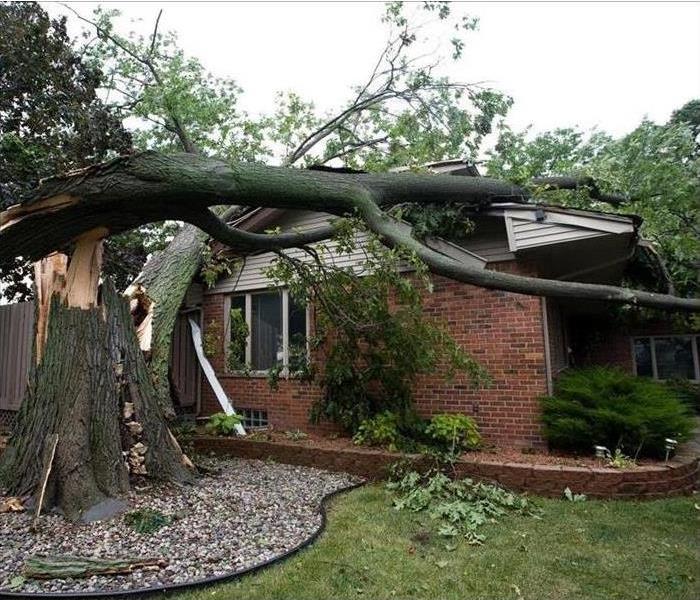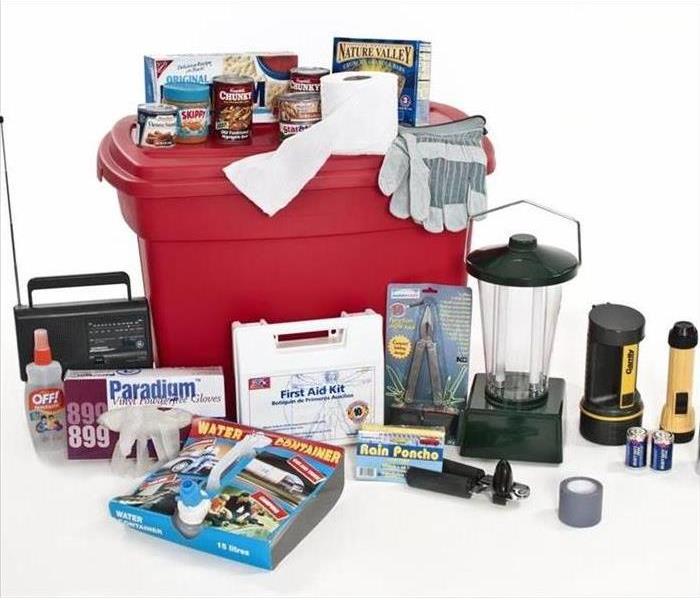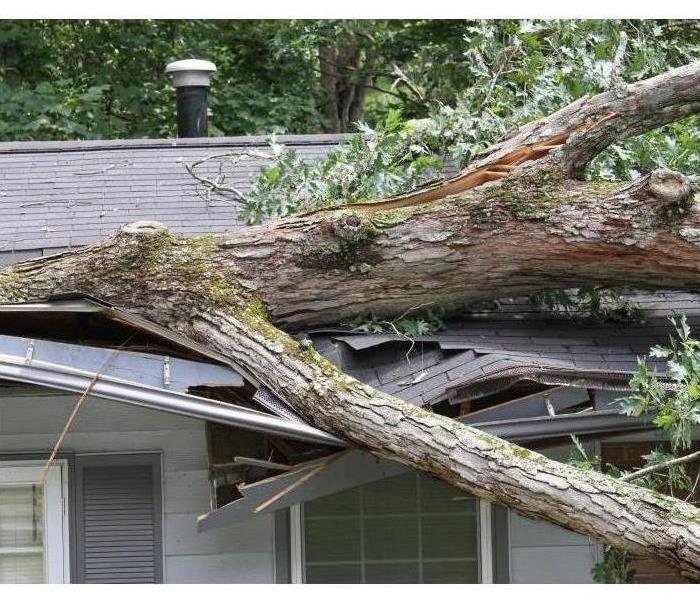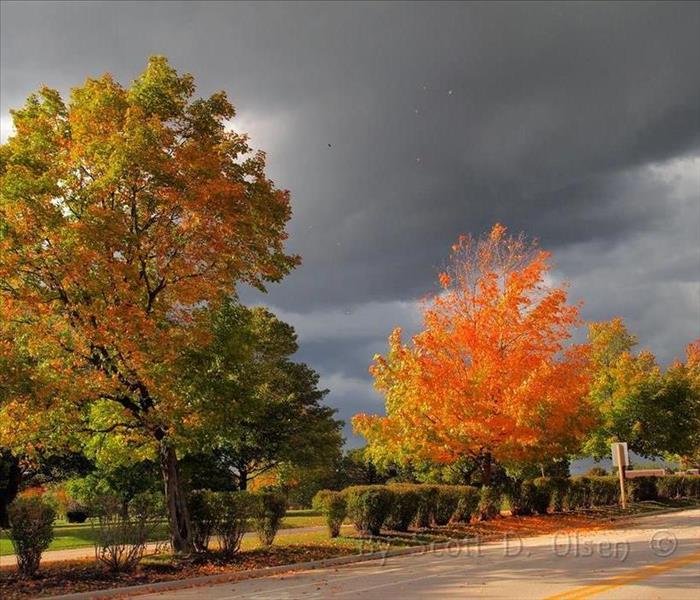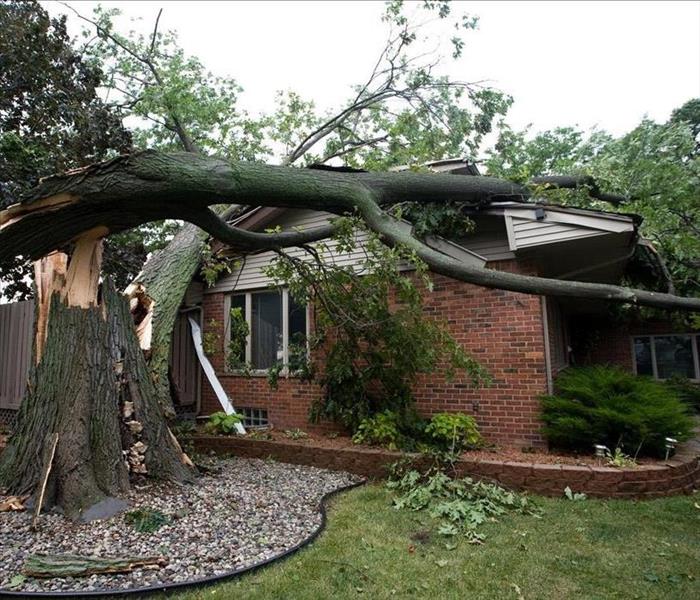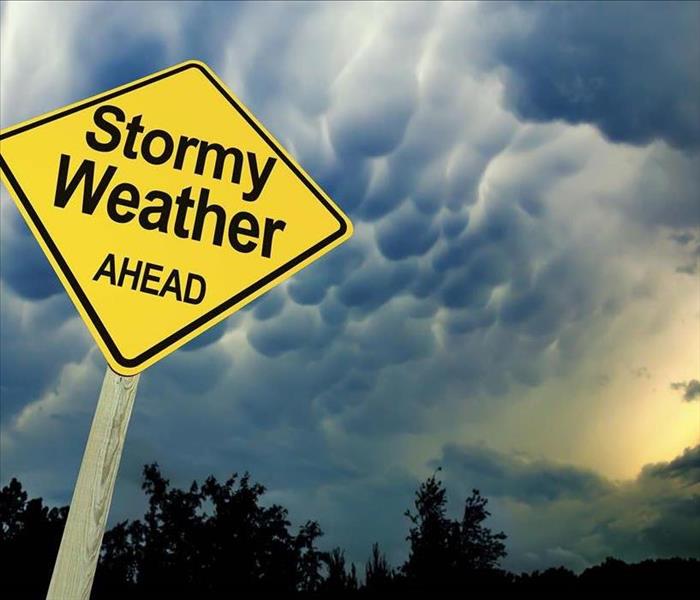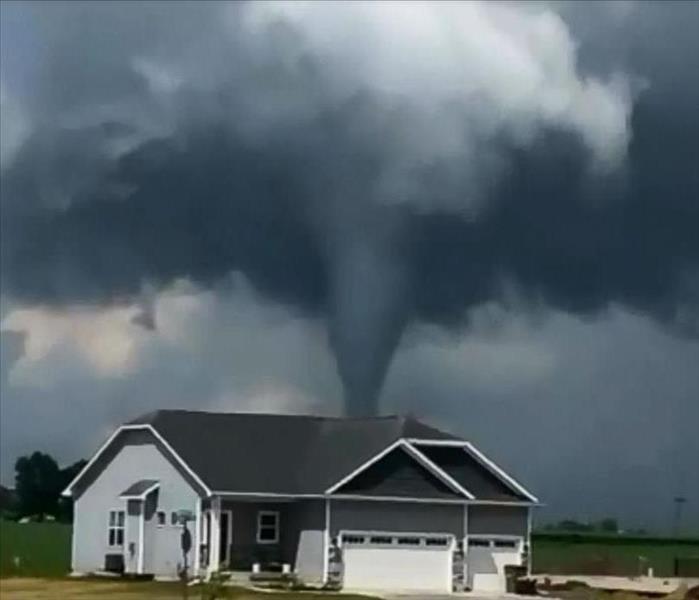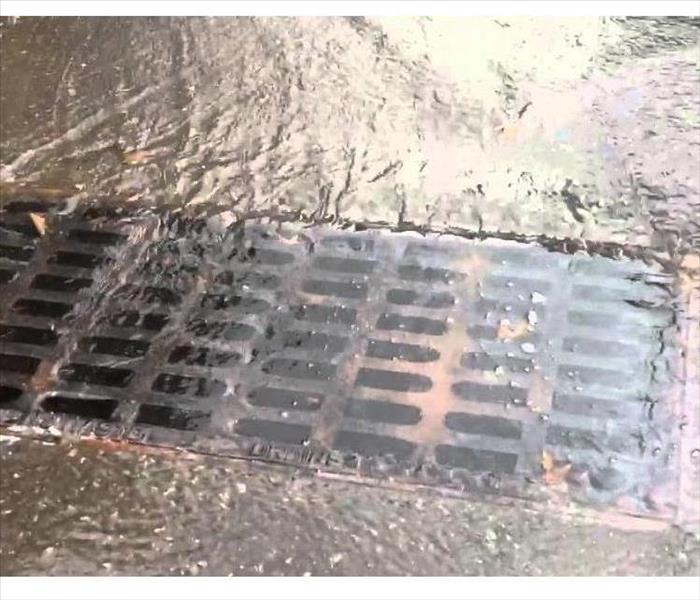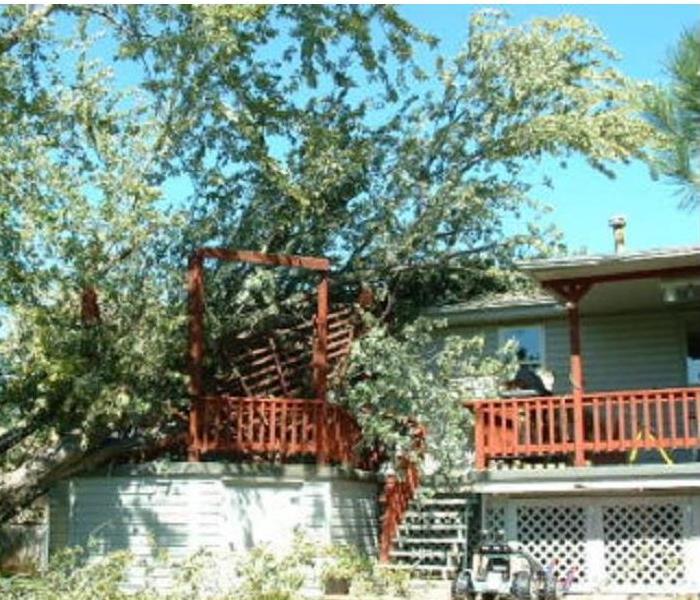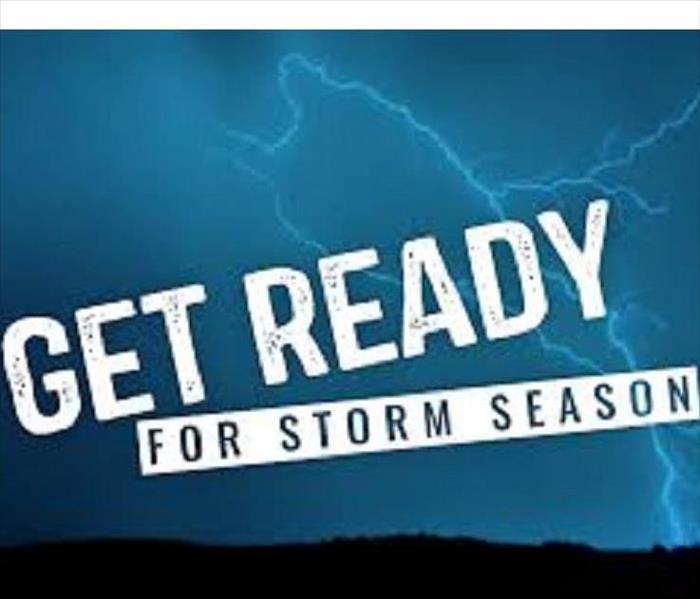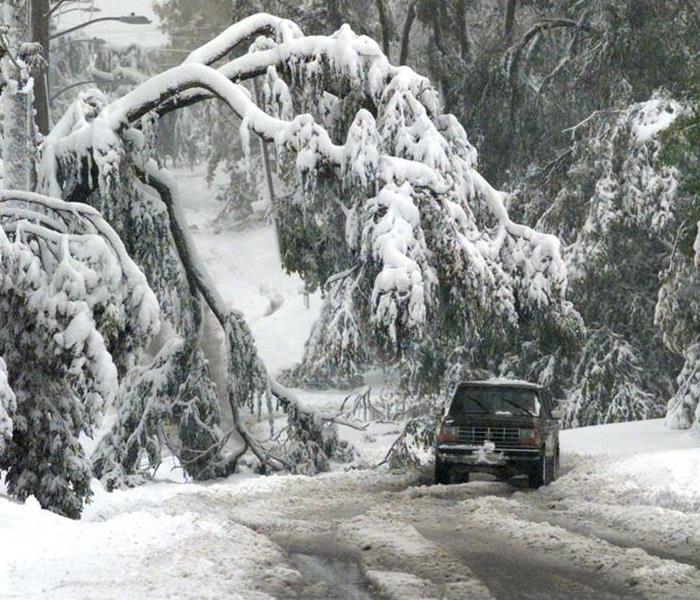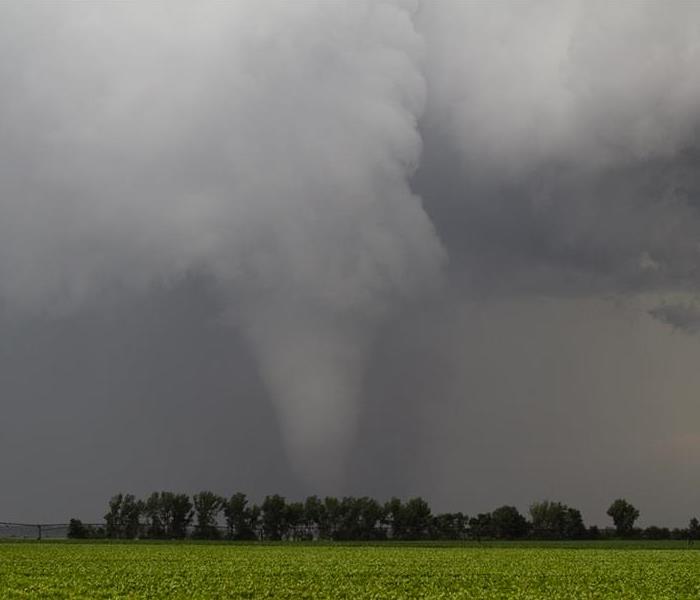Recent Storm Damage Posts
Repairing Neighborhoods: Trusted Storm Clean-Up Services in Lincoln, NE
4/1/2024 (Permalink)
If disaster hits your property, the road to recovery may seem daunting, but at SERVPRO of Lincoln, serving the Lincoln, NE area, we're here to help you recover after disaster strikes.
- Prompt Response: Our Disaster Response Team is prepared to respond swiftly to storm damage emergencies, providing immediate assistance and support.
- Complete Solutions: From debris removal to structural repairs, we offer comprehensive storm clean-up services tailored to your needs.
- Commitment: We're dedicated to serving our community and helping residents restore their properties and their lives after a storm.
When storm damage strikes, call on SERVPRO of Lincoln to be your partner in recovery. Contact us today for reliable and compassionate storm clean-up services in Lincoln, NE.
Storm Weather and How to Prepare for Restoration
4/19/2023 (Permalink)
Storm weather can be unpredictable and can cause significant damage to your home or business. High winds, heavy rain, hail, and lightning strikes can all wreak havoc on your property, leaving you with the need for restoration services. At SERVPRO of Lincoln, we understand how stressful it can be to deal with the aftermath of a storm. That's why we've put together this guide on how to prepare for storm weather and what to do if you need restoration services.
Preparation is Key
The best way to deal with storm damage is to prevent it from happening in the first place. Here are some tips on how to prepare for storm weather:
Keep your gutters clean: Clogged gutters can cause water to overflow and damage your roof, walls, and foundation.
Trim trees and shrubs: Trim any branches or shrubs that are close to your home or business. Strong winds can knock them down and cause damage.
Check your roof: Inspect your roof for loose or damaged shingles. If you notice any issues, have them repaired before a storm hits.
Secure outdoor items: Bring in any outdoor furniture, toys, or decorations that could be blown away by strong winds.
Install storm shutters: If you live in an area prone to hurricanes or tornadoes, consider installing storm shutters to protect your windows.
What to Do After the Storm
If your home or business has suffered storm damage, it's important to act quickly to minimize the damage. Here are some steps to take:
Assess the damage: Once it's safe to go outside, inspect your property for any damage. Take photos of the damage for insurance purposes.
Call SERVPRO of Lincoln: Contact our restoration experts as soon as possible. We can help assess the damage and begin the restoration process.
Stay safe: Don't attempt to enter your home or business if there is standing water or if the structure has been compromised.
Document the damage: Make a list of any damaged items, and take photos or video of the damage.
Contact your insurance company: Notify your insurance company of the damage and provide them with the documentation you've collected.
Let SERVPRO of Lincoln Help with Restoration
At SERVPRO of Lincoln, we have the experience and expertise to restore your home or business to its pre-storm condition. Our team of restoration experts will work quickly to mitigate the damage and get your property back to normal as soon as possible. We offer a range of restoration services, including water damage restoration, fire damage restoration, and mold remediation.
Don't wait until it's too late. Prepare your home or business for storm weather, and call SERVPRO of Lincoln if you need restoration services. Contact us today to learn more about our restoration services or to schedule a consultation 712-274-2416.
Water Damage Cleanup Mistakes
8/3/2022 (Permalink)
Water damage cleanup mistakes can lead to a lot of headaches and stress. If your property needs water damage restoration, here are a few of the mistakes you’ll want to avoid.
Waiting Before Cleanup
Water damage can lead to a lot of problems. The first rule of cleanup is to do it as soon as possible. Every minute that your belongings and property stay submerged lessens the chances of you getting that item or property back to its pre-damaged state. If you wait until it’s convenient to perform the cleanup, you’ll only end up with bigger problems.
Wrong Equipment
Using the wrong equipment will only aggravate the problem. Plus, the kind of equipment or tools you have might not be suitable for handling the water in your home. That means you won’t succeed at drying your home completely, which will leave your home at the mercy of mold and mildew growth. Don’t let that happen. Hire pros to handle this for you. They have specialized equipment to ensure the fast and efficient drying of your belongings and property.
Neglecting Important Details
Most of the time, people forget about the items they slog through when they wade through water damage. But there could be an electrical problem, broken glass, and other items that could injure you. It’s best that you hire pros instead of tackling this on your own. Restoration experts know what to look out for and how to do this in the safest way possible. They’re much better equipped to handle this than you with your makeshift tools.
Not Doing Your Homework
When you look for a restoration service, don’t hire the first company that you find. Look at the company’s history and background. SERVPRO of Lincoln is your trusted resource for cleaning and restoring water-damaged property. Our teams are IICRC certified. We have the latest advanced equipment and training to make sure your water damage problems are solved completely.
If you have water damage to your home or business property, call us anytime 24/7 at 402-466-4004. We'll be there to help!
Commercial Storm Damage
8/3/2022 (Permalink)
Storm Damage to Commercial Properties
Storms and dangerous weather can be devastating to any business. Wind damage, heavy rain, and flooding can occur suddenly and cause substantial damage in a matter of minutes. There’s never a convenient time for flooding or storm damage to strike your business. Every hour spent cleaning up is an hour lost revenue and productivity. So, when an emergency situation arises in your business, give us a call and we’ll be there as fast as we can with the help you need.
Commercial Restoration Presents Unique Challenges
SERVPRO has the training, experience, and equipment to handle large commercial storm or water damage emergencies. Regardless of your property type or size, we will respond quickly to clean the property and manage the restoration project through to its completion.
We're ready to take your call. The IICRC trained and certified staff at SERVPRO of Lincoln can handle cleanup and restoration of your commercial property and help you get back in business fast. Call us 24/7 at 402-466-4004
What should I do if my home is flooded?
2/8/2022 (Permalink)
Don't take a flooded home as a lighthearted matter. You should be very serious in your attempts to enter your home after it has been flooded. Keep these in mind after a flood damage in the Lincoln area.
- Disconnect all the Electronics - these can start fires if left on
- Move anything not Bolted to the Ground - furniture and tables should be moved out
- Have a Restoration Company Remove the Water - extraction of water helps with the drying process
- Get Rid of Moisture in the Affected Area - dehumidification will keep the mold from growing.
- Disinfect the House - part of the cleaning process is to disinfect the house before rebuilding.
- Dispose of Waste Responsibly - tearing out items from the home is naturally the case. Remember to take into consideration items with asbestos or you could be fined for disposing them incorrectly
Things To Do Before Help Arrives
10/26/2021 (Permalink)
If your home or business has water damage, you can do some things before help arrives.
Make sure that the building or home is safe.
SERVPRO of Lincoln Wants You to Remember:
- Waterlogged materials are very heavy
- Wet surfaces are slippery
- Make sure electrical power is off before you handle devices
- Make sure you are standing on dry area before you turn on the electric power
SERVPRO of Lincoln suggests that you:
- Remove excess water with mops and/or towels
- Wipe water from wood furniture or other items
- Remove wet cushions. Prop them upright to dry
- Hang up rugs to dry
- Place foil or blocks between furniture and wet carpeting
- Turn on dehumidifiers or air-conditioning if it is safe
- Move colored items from wet carpeting
- Move artwork to a safe, dry place
- Move loose items from the floor or counters
- Start drying items ASAP
- Remember that mold starts growing within 24 hours
- Stay away from rooms that have sagging ceilings.
Preparing Our Youth For Disasters and Emergencies
10/1/2021 (Permalink)
When the unexpected happens, will your child know what to do? Disaster can strike anywhere, usually with little to no warning. If your child is put in an emergency situation and doesn't know how to react, they could be severely hurt and may even feel significant anxiety that can follow them for years. With the proper education, though, your child can feel more secure, confident and helpful in the event of a disaster.
Preparing Our Youth
Ultimately, it takes the whole community to educate our youth through preparedness tips and advice. With everyone doing their part, children will understand the seriousness of an emergency situation and strive to become leaders in their classrooms and neighborhoods, ensuring that everybody is prepared for the next disaster. The Federal Emergency Management Agency (FEMA), the American Red Cross and the Department of Education have worked together to create the National Strategy for Youth Preparedness Education a document that outlines a vision for prepared youth in the United States, and how communities can turn that vision into a reality. This document seeks to educate youth and their parents so that communities are better able to prepare for, respond to and recover from future disasters.
How to Prepare Youth for Emergencies and Disasters with Nine Steps
The National Strategy document indicates nine crucial steps that people and organizations at the local, state and federal levels should take to create a strong and prepared youth community. Here's how you can help prepare young people for several types of emergencies and disasters:
- Make it important. Elevating the importance of youth preparedness learning programs in schools and civic organizations allows children to recognize that being prepared is crucial throughout every area of the community.
- Evaluate. If existing youth preparedness programs aren't up to par, develop guidance, tools and up-to-date protective actions in order to ensure that the children in your community are given proper direction.
- Support. Communities, organizations and schools should be able to prepare children without facing unnecessary resistance or interference.
- Create. Establish a relationship between local youth and the first responder community, so that your kids can understand how first responders react in emergency situations. Your kids can also learn from their own heroes what they can do to help in a disaster.
- Link. Connect youth preparedness to family and community participation, so that your child can become an advocate in your area.
- Make school preparedness key. Schools, by their nature, promote broad community participation already, so adding preparedness programs that include curricula, drills and exercises for all local disasters can help children understand what to do when faced with a crisis.
- Build and strengthen. Creating and maintaining partnerships among stakeholder agencies and organizations allows your community to receive up-to-date information about youth preparedness best practices. Local leaders can also be advocates to discuss your community's needs, especially if your area is prone to certain natural disasters.
- Identify. Find opportunities to insert youth preparedness education into youth culture, such as using social media or local ads to initiate a conversation about the importance and effectiveness of preparedness programs.
- Design. Create a sustaining model that designs, develops and delivers valuable programs to train youth in your community. Since certain areas are known to have specific recurring natural disasters, it's important to create a plan that's unique to your community's needs.
By implementing these nine priority steps in your community, your children can receive training to help them feel confident when faced with a disaster. Giving them the tools they need to understand how to prepare for, respond to and recover from several types of emergencies – from fires to floods and more – can make all the difference when disaster actually strikes.
Flooding and Your Basement
10/1/2021 (Permalink)
A flooded basement hits like an oncoming train. Whether the problem stems from a broken pipe, failed sump pump or the result of a heavy downpour that found its way inside, a flooded basement needs to be dealt with immediately to prevent long-term damage.
When dealing with basement floods, there are some things you can and should do immediately, some things you might want to consider doing in the future and times when you should really call in the professionals.
Flooded Basement: Safety First
Safety should always be a priority. Entering a wet basement can be dangerous and even deadly. Before stepping into a flooded basement consider the following:
- Is there a risk of electrical shock? If it's safe to access the main breaker box, turn off the power before you enter the basement. If the breaker box is located in the flooded basement, contact your local power company or a trusted electrician to help first.
- Do you smell gas? Gas leaks are deadly and dangerous. If you smell gas, get out of the house and alert your utility company.
- Is the flood water contaminated? Sewage, chemicals and other pollutants in flood waters pose a health risk to humans and animals. Avoid contact with contaminated flood water and any items that may have been in contact with contaminated flood water.
- Is the flooded basement still structurally safe? If there is any question regarding the structural integrity of the flooded basement or the house above it, do not enter. Call for professional help.
How to Clean Up a Flooded Basement
If it's safe to enter, there are several things you can do to begin cleaning up your flooded basement. Before you dive in, remember the first rule is always safety. Wear protective clothing, safety glasses and gloves as you clean and inspect the basement. Make sure the space is well-ventilated, which also speeds the drying process.
Retrieve and remove: The quicker your personal items can be removed from water, the better the chances for repair and restoration. You need to get items out of the basement and dry off any remaining dampness to reduce the likelihood of mold growth.
Extract water: If the water is just a couple inches deep, you may be able to remove it using a wet/dry vacuum or portable sump pump. Both of these items can be rented rather than purchased. If you're wading through several inches of water or more, though, you'll likely need to call in professionals like those at SERVPRO of Lincoln.
Remove rugs: Any area rugs need to be removed and dried out immediately. If possible, hang area rugs outdoors to dry or opt for a professional cleaning. If the basement was carpeted, you may have to remove the carpet. Water can damage not only the carpet fibers but also the glue, backing, padding and underlayment, leaving the carpet at higher risk for mold. However, do not attempt to remove tacked-down carpeting yourself, leave it to the professionals.
Run a dehumidifier and fans: To prevent the development of mold after a basement flood, it's essential to keep the level of humidity as low as possible. If the weather is favorable, open any and all windows you can, then run a dehumidifier and fans to increase ventilation and lower the humidity levels.
Clean and disinfect: After the water is extracted and the basement thoroughly dried, the whole space needs to be cleaned and disinfected. Carefully wash and sterilize anything the flood waters touched that you were able to salvage.
Keep an inventory list: As each item is removed from your flooded basement and treated for water damage, add it to an inventory list. Keep a record of all the details regarding what was damaged in the flood, and hold onto estimates and receipts from any restoration or repair procedures. These documents will support any insurance claim you plan to make.
SERVPRO has been helping homes and businesses cope with water damage for more than 54 years. When your basement floods, call SERVPRO of Lincoln to handle the water extraction, drying and any necessary mold remediation.
How To Prepare Your Home For A Storm
8/2/2021 (Permalink)
Quick guide to preparing for a storm
- Ensure your drains and gutters are clear of debris to prevent blockages.
- If safe to do so, check your pipes and water tanks are insulated to prevent freezing and that the release point of overflow pipes is not obstructed. Ideally, you'll have a regular maintenance program in place.
- Cut back trees and branches to minimize the risk of falling branches.
- Secure loose fences.
- Check that roof tiles and aerials are secure if you can do this safely. It may be worth seeking professional advice.
- Make sure garden furniture and ladders are secured in case of high winds or locked away in the shed or even inside your house.
- When you know a bad storm is on its way with warnings about gale-force winds and floods, make sure children, pets and your family and neighbors are safe. Make sure you're indoors when it hits and don’t try and repair damage during a storm.
Always be cautious when undertaking any task that you're not fully familiar with as you could injure yourself or those around you, seek professional help where required.
So, this winter, make sure you're storm ready. Secure loose objects such as ladders and garden furniture. Close and secure all windows and doors. Check on loved ones before a storm strikes, but once it arrives, stay indoors. Do not try to drive or move around outside near trees or buildings that could collapse.
Protect Yourself From Storm Damage
8/2/2021 (Permalink)
Storms can be severe and leave a trail of destruction in their wake from flooding, strong winds and lightning.
Insurance claim costs are estimated to have reached astronomical amounts, with households suffering millions more dollars of uninsured financial losses dealing with the aftermath of those violent storms.
Worryingly, changing weather patterns means these damaging wind storms could become a regular winter staple, sweeping into parts of the country even earlier in the season. Preparing your home to cope can help to limit the damage that a storm may cause, including from flooding.
Thankfully, weather forecasting has improved and knowing if bad weather is on its way can be helpful in getting your house storm ready.
Did you know?
- The annual cost of storm damage can amount to millions each year.
- Thunderstorms develop when the atmosphere is unstable – typically forming a ‘cumulonimbus’ (rain/storm) cloud.
- These large clouds (often accompanied by large gusts of wind) can form in under an hour if the conditions are right – meaning there may not be much time before the storm hits!
The Purpose of Flood Cuts
2/8/2021 (Permalink)
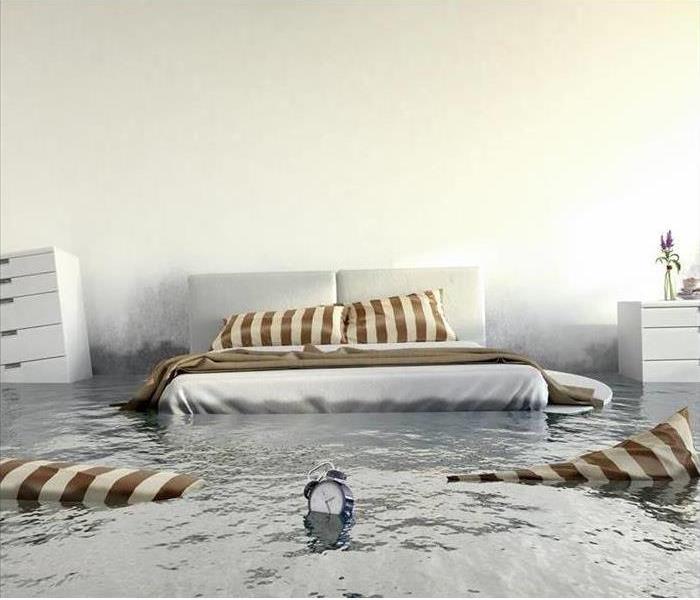 Heavy storms can lead to severe flooding damage.
Heavy storms can lead to severe flooding damage.
A heavy storm can cause a significant amount of damage to your home. Lightning can strike trees, causing them to fall on the house and tear up the roof. High winds that pick up debris can lead to broken windows. The main concern during a storm, however, is likely flooding. If a weather event in Colorado Springs, CO, leaves behind a lot of standing water in your home, flood restoration specialists may have to make a flood cut to remove all the damage.
When Is a Flood Cut Necessary?
A flood cut is the method the cleanup team uses to tear out materials that can't be salvaged. Technicians will probably need to use a flood cut if the water damage meets certain criteria:
- High levels of contamination
- Suspected damage in hard-to-reach areas
- Compromised structural integrity of the wall
Flooding from a storm almost always leads to a flood cut because the water is contaminated. If the standing water in your home comes from a clean sources, however, technicians may try to save the wall, even if there is a lot of water.
How Is a Flood Cut Measured?
When removing drywall, the mitigation team wants to make sure that it tears out all the damage. Specialists typically make a flood cut at least 12 inches above the spot where the water damage ends. This ensures that any unseen damage is also removed.
What Happens After the Flood Cut Is Made?
Once the cut is made, the technicians remove the drywall. They take out all the damaged material, including any damp insulation behind the wall. Before they rebuild, they have to make sure the area is clean and dry so that no secondary damage occurs.
If a storm causes flooding in your home, it may take more than simply removing the water and wiping down surfaces to complete the repairs. Technicians may have to make flood cuts on your walls to remove all the damage.
Winter Storm Hazards
10/26/2020 (Permalink)
 Give us a call, we will assess the situation like it never happened.
Give us a call, we will assess the situation like it never happened.
Winter Storms can bring many hazards
Many destructive impacts can come out of a single winter storm. Are you prepared for the coming winter? The array of hazards that can come from a winter storm are sometimes countless.
- Ice: Accumulations of a half inch or more, because of it's weight can cause widespread destruction and power outages and can have a crippling impact.
- Wet Snow: Much like ice accumulation, wet snow adds extra weight and stress, increasing the chance of damage. Moist snow sticks easily to trees and power lines.
- Snow on Roofs: Several feet from one or multiple storms accumulating on a roof can add stress, causing them to collapse.
- Flooding After the Snow: A rapid warm-up or rain following a winter storm with an expansive snow pack can set the stage for major flooding.
Melting snow and ice after a storm can also cause damage to the inside of your home or business. Call the professionals at SERVPRO of Lincoln to assess the situation and put you to Pre-Winter condition, "Like it never even happened."
Call us 402.466.4004
Frozen Pipes: A Winter Water Damage Emergency
10/26/2020 (Permalink)
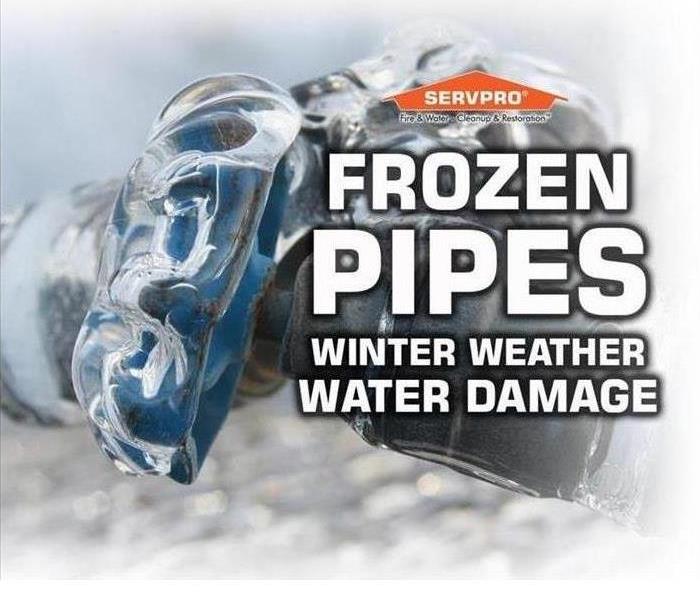 Low Temperatures can freeze pipes, make sure you are keeping an eye on your home during winter.
Low Temperatures can freeze pipes, make sure you are keeping an eye on your home during winter.
We can’t control the weather frigid winter temperatures are here in the Midwest, the lower temperatures cause a new set of seasonal Nebraska property disasters including frozen pipes, ice dams and other frozen water damage concerns.
Every winter our SERVPRO of Lincoln professionals help countless homes with the restoration, cleanup and repair of their property following a frozen water property disaster.
Why is a Frozen Pipe a Concern?
- When water begins to freeze, it expands. This can cause both plastic and metal pipes to burst, possibly leading to significant water damage to your home or business.
- Since water expands when it freezes, it puts unwanted pressure on pipes.
- As water freezes, the force exerted from the expansion can cause a pipe to burst, regardless of the strength of the material.
- You may not know you have a burst pipe as the water has turned to ice. Once the temperature starts to warm and thawing begins, leaking and flooding can occur.
FROZEN PIPE WATER DAMAGE TREATMENT AND RESTORATION
The key to avoiding costly secondary damage is to handle every water problem as a real threat to your property with proper mitigation. Our SERVPRO of Lincoln team has the equipment, training and experience to find and dry unseen water before secondary damages occur. We begin removing the standing water from your property with extraction methods, and rapidly dry your structure and contents with dehumidifiers that lower the indoor humidity levels, so your building dries out quickly. When time matters, technology and equipment must be counted on to perform. SERVPRO of Lincoln professionals will answer your call with rapid action and a full arsenal of drying equipment.
FROZEN PIPE PREVENTION
Short- and Long-term solutions for low temperature plumbing problems include:
- Locate and seal cracks and openings in the walls, attic, basement or crawlspace.
- Weather strip and caulk around crawlspace doors and basement windows.
- Make sure your home is properly insulated. Pay special attention to areas where pipes are located.
- Insulate unprotected pipes and don't leave gaps. Pipe sleeves simplify the process. Keep the pieces tight against each other and seal the slits and joints with duct tape.
- Install storm windows over basement windows or replace the old windows with energy-efficient alternatives.
- Find your main water shutoff so you can turn off the water quickly if needed. Locations vary — look in the crawlspace or basement where the water supply enters the house, inside a water meter box directly outside the house or near the water heater.
- Open cabinet doors under sinks to let warm air flow around the supply lines. Move any cleaners or other chemicals out of the reach of children.
- Keep your thermostat at the daytime setting during the night. If you'll be away for several days during subfreezing weather, keep it set above 55° F.
Autumn Storms
10/6/2020 (Permalink)
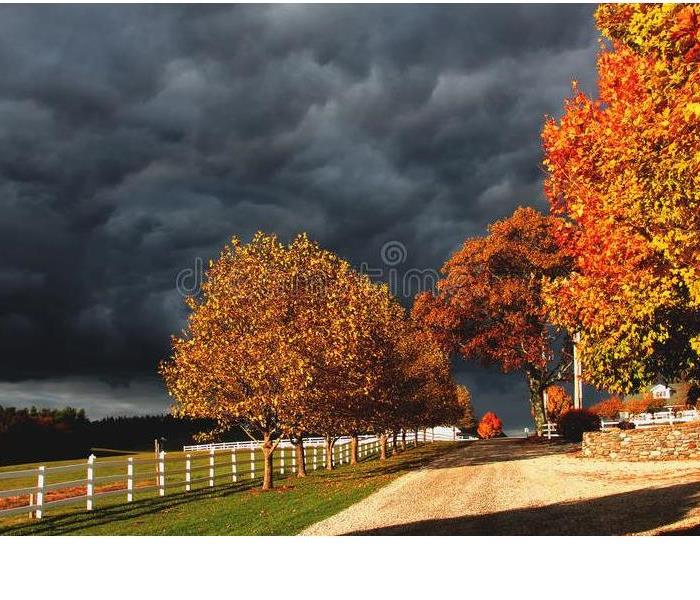 Autumn Storms
Autumn Storms
Autumn Storms
Autumn storms are right around the corner. The effect of these storms can be good or bad. As much as we love the sound of thunder, the jolt of lightning going through the sky and the smell of rain, there are bad things that can come along with it. Power outages are often a risk associated with storms. It’s good to know what to do in case you lose power, because you never know how long it could be out. It could be out for a matter of seconds, or for several hours. Here are some tips on what how to be prepared, and what to do during a power outage.
- Keep flashlights available around your house. Avoid using candles when possible.
- Keep the opening of freezers and refrigerators to a minimum. When kept closed, refrigerators can stay cool up to 4hours, and freezers can stay frozen up to 48 hours. If need be, you can put ice in a cooler to keep your food cold.
- Watch out for carbon monoxide poisoning. If you are running a generator, it should be used outside and at least 20 feet away from a window or door. Never use a gas stovetop, oven, camp stove, or charcoal grill to heat your home.
- If it’s cold in your home, add more layers of clothes and blankets. Don’t use the oven or a grill as a heating source. If it becomes too cold, try to make arrangements to go to another location where heat is available.
- Turn off and disconnect any appliances and electronics. The power may surge or spike when it is restored, and that may cause damage to the items.
- If you have a sump pump, keep an eye on it so you don’t end up with a flooded basement.
If a storm occurs, the safety of you and your family is of the utmost importance. Be safe out there!
SERVPRO of Lincoln specializes in the cleanup and restoration of residential and commercial property after a fire, smoke or water damage event. We can handle any size disaster!
Call us at (402) 466-4004
Sometimes you CAN have too much rain.
8/17/2020 (Permalink)
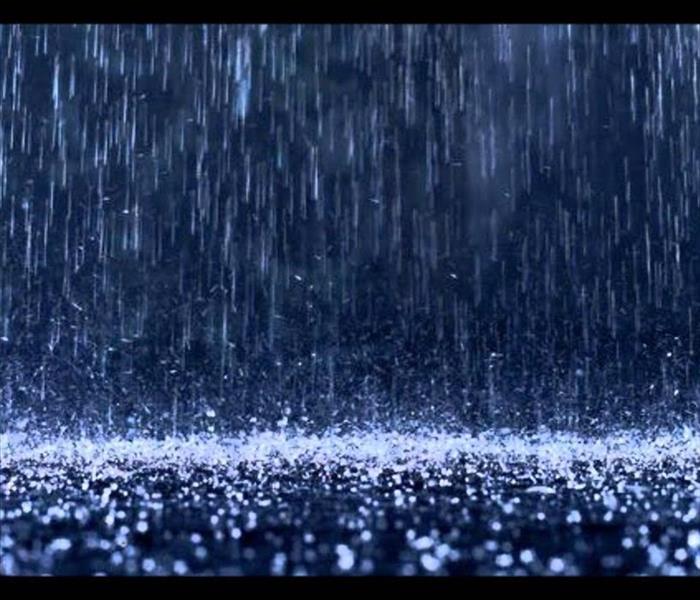
In the case of a storm, heavy rainfall can infiltrate a home or business very quickly. Most of the time it is a problem in the lower level or basement of a home or in a crawl space. Water can seep in and penetrate under garage doors, around improperly sealed windows, and through cracks in the cement foundation or walls. It is important to note that water will always travel the least path of resistance. If you find water where you don't want it and you don't know how to remove it, so we are Here to Help. ® SERVPRO has several different forms of extraction equipment and is ready for 24/7 with our emergency services. It is very important to remove the water as soon as possible to prevent further wicking into the structural materials of the building. It can be difficult to remove without the right equipment. This is where we, SERVPRO franchise professionals, come in. We will extract the standing water and then set drying equipment to remove moisture from the structure. Always remember to call right away when you see a problem for help. Water is something you want to clean up right away so further problems don't occur.
SERVPRO of Lincoln specializes in the cleanup and restoration of residential and commercial property after a fire, smoke or water damage event. We can handle any size disaster!
Call us at (402) 466-4004
You can Weather any Storm.
8/17/2020 (Permalink)
As a business, it is your job to weather any storm that comes your way no matter the type or size. Sometimes physical storms are unexpected and can be quite devastating and detrimental to a business. Here at SERVPRO, our job is to give some peace of mind and help instigate water and fire damage cleanup and restoration. We are capable of traveling anywhere to help get the property back to preloss conditions. Our SERVPRO team of franchise professionals have access to a semi-trailer that is meant to stock up for any disaster that could strike your business. We make our services available 24 hours a day for 365 days a year for whatever could happen. We want to ensure you will be helped during overwhelming and unexpected times. We come ready for whatever disaster occurs. No matter the weather or time of day, we will be there to assist.
SERVPRO of Lincoln specializes in the cleanup and restoration of residential and commercial property after a fire, smoke or water damage event. We can handle any size disaster!
Call us at (402) 466-4004
Groundwater Flood Damage and Pack-out Procedures
2/4/2020 (Permalink)

Sustained rainfall can result in groundwater flooding of your property. Not only do high standing water levels exert significant pressure on your walls and flooring, but they can also carry high levels of contamination. As a homeowner, you may be able to deal with clean water emergencies yourself. However, floodwaters carry with them infectious waste, which can be harmful to your health.
You need professional assistance from trained technicians to overcome flood damage to your home. At SERVPRO, we run a unique out-of-hours emergency service for victims of groundwater, flash flooding, or storm-related events. We will ensure that your property and contents sustain as little harm as possible. We strive to reduce the expense of your claim by using our advanced equipment and professional expertise to repair the damages quickly.
In severe flooding scenarios, it may be necessary to store your contents at the separate facilities while work is undertaken. Separate storage can frequently mitigate against further losses while we work to restore the structure itself. When a pack-out service is necessary, SERVPRO technicians take an inventory of your possessions, their condition, and the rooms to which they belong. This ensures you are covered in the unlikely event of transit damages.
One advantage of a pack-out procedure is that it can significantly reduce the timeframe of your property restoration. Less furniture provides greater access to all areas of your home's structure. This access can be helpful should we need to perform structural or cavity drying as well as demolition of non-salvageable materials. Once your property has been returned to a sanitary condition, we can use our automated inventory to put furniture and possessions back where we found them.
SERVPRO of Lincoln specializes in the cleanup and restoration of residential and commercial property after a fire, smoke or water damage event. We can handle any size disaster!
Call us at (402) 466-4004
Getting Prepared for any Disaster
10/31/2019 (Permalink)
The American Red Cross encourages that each household and car have a preparedness kit, but sadly only 51.5% of US homes reportedly have an emergency kit ready. Kits should include things like water, canned food, a can opener, flashlights and batteries, including enough food and water for each person in your household for 5 days. Start with a power outage kit, grab an old backpack or duffel and add in plenty of bottled water, battery-operated radio and clock, flashlight for each member of your household including extra batteries, non-electric can opener, list of emergency phone numbers including family and friends and a first aid kit.
SERVPRO of Lincoln specializes in the cleanup and restoration of residential and commercial property after a fire, smoke or water damage event. We can handle any size disaster!
Call SERVPRO of Lincoln 402-466-4004
Keeping your home safe from storm damage.
10/29/2019 (Permalink)
Storms can come upon us without much warning. Yes, we watch the news, but bad weather is still unpredictable, so we need to take steps to keep our homes safe from storm damage.
An inspection of your home’s premises is a really good idea to conduct before inclement weather hits. A leaky roof or windows can cause big problems during extreme conditions such as a snow storm or heavy rains. Do all your exterior doors and windows fit correctly? When’s the last time you took a look at your roof to see how things are looking up there? These are all great questions to ask yourself.
Loose shutters and rain gutters can present a real problem in high winds, as can unstable large trees. It might be a good idea to trim back trees and bushes with large heavy branches that are not in good condition, so that windows and vehicles are not in danger of storm damage in windy conditions.
Many homes in older cities have drainage ditches at the front of the property. Take time to inspect this area and remove debris or dirt that might obstruct the flow of water from a heavy rain. A clogged drainage ditch can cause a lot of damage by flooding your property during, or even after, a storm.
Your family is very precious to you. In the event of a storm, do you have a system in place that will help you to get information to everyone in case of a weather emergency? Most of us use our cell phones to communicate these days, but in the case of a bad storm, your cell phone service could be at risk. You might consider installing a good old-fashioned landline, just in case. If you or a family member gets stuck at work or out doing errands, families will worry, so it’s vital that lines of communication stay open.
SERVPRO of Lincoln specializes in the cleanup and restoration of residential and commercial property after a fire, smoke or water damage event. We can handle any size disaster!
Call us at 402-466-4004
Floods are the most common natural disaster in the US.
10/28/2019 (Permalink)
Floods rank as one of the most common and widespread natural disasters in the United States. Whether you live near a coastline, along a city streets, in the mountains, out in the country, or even in the desert, there is potential for flooding. Anywhere it can rain, it can flood. In the past ten years, the average annual flood losses in the U.S. were more than $29. Billion according to floodsmart.gov. A variety of events can cause flooding, like: heavy rains, when ocean waves come onshore, if snow melts too fast, or when dams or levees break. A flooding event may occur over a long periods and could last days, weeks, or longer.
SERVPRO of Lincoln specializes in the cleanup and restoration of residential and commercial property after a fire, smoke or water damage event. We can handle any size disaster!
Call us at (402) 466-4004
An ounce of prevention is worth a pound of cure.
9/6/2019 (Permalink)
It’s that time of year again, The pigs skins are flying, the sea of red is hoppin, kids are back at school, life takes over, and fall is right around the corner. Benjamin Franklin said it best. “An ounce of prevention is worth a pound of cure”
As fall approaches it is never to early to “water proof” your home for for the upcoming fall/winter seasons. These seasons can be very unpredictable in the Midwest. Whether it’s a downpour rain, rain/snow mix or an early Halloween snow all of these can create potential water damage issues to your home or business. Whether you are the DIY type or need to contact a local contractor the following are some useful tips to prevent these untimely and costly hazards from happening.
In preparation you should do the following.
*Have a licensed contractor do a thorough roof inspection on the following.
*Check and seal any exposed nails around vents and penetrations.
*Check roof for any low exposed nails.
*Inspect your attic for any existing slow leaks.
*Do a thorough gutter inspection, including mitres,hangers and spikes and seal any
Problem areas accordingly. Also be sure all gutters are clear of debris.
*Do a thorough window inspection and seal and draft or compromised areas.
*Contact a local sprinkler contractor to winterize your sprinkler system. As the ground begins to freeze unhook all hoses and lock spigots to the off position.
*Download FEMA’s Be Smart. Know your alerts and summary’s for a summary of notifications.
*These a few of the key factors and readiness tips to storm proof your home or business.
SERVPRO of Lincoln specializes in the cleanup and restoration of residential and commercial property after a fire, smoke or water damage event. We can handle any size disaster!
Call us at (402) 466-4004
Types of Storm Damage.
9/6/2019 (Permalink)
Living in the Midwest can always be a challenge particularly in Lincoln and surrounding areas. There are many types of storm damage that can affect your home or business. Some of these include wind damage, flood damage, and hail damage. Here are some tips to consider should storm damage hit your home or commercial property.
Wind damage
High Wind are common occurrence in Nebraska. Your roof is particularly susceptible. Roof leaks can often lift shingles, cause cracks, and even remove portions or complete roofs. Flying debris can also cause cracks and holes in your siding or cause leakage through chimneys and soffit gable vents. All of these may factor into water invading your residence or business.
Roof Leaks.
Why are roof leaks from storm damage so hard to detect? Many storms may loosen flashing creating a problem that is not visible to the naked eye. Loose flashing can cause roofs to leak occur even up to weeks after the initial storm occurs. Even a small roof leak can produce damp, moldy conditions inside your home or business. Your best bet is to secure a repair immediately after the wind damage. Doing so can prevent long-term interior damage. Contacting a storm damage professional at SERVPRO of Lincoln will guarantee you a comprehensive damage assessment and repair of services needed to give you peace of mind and protect your home or business long term.
Flood damage and recovery
If Your home or business is near water or in a low lying area, flood water damage is a risk. Heavy rains and snow may cause water damage to your property.Many factors such as flood pump failures, and frozen pipes can factor in causing additional damages such as contaminated ground water invading your property.
By relying on a train SERVPRO trained Water Damage Restoration Specialist, you will obtain faster storm remediation. Our experts will recommend ways to help mitigate flood water damage in the future, for instance, by requesting back up flood pump installation.
Hail Damage
Hail may Be one of the most overlooked causes of major storm damage. Hail Can damage not just your roof but also your siding, roof decking, exterior walls, or any detached sheds or outbuildings. You may believe that you have escaped any damage to your home especially with damage that is not always visible to the naked eye. Hail damage can cause small bruises to your shingles that overtime will expand, becoming larger, therefore causing rain to penetrate through the base of the shingles and intrude your attic space. This can lead to moldy conditions and interior leaks to your property over an extended period of time. Again, at the smallest evidence of moisture issues after a storm it is wise to contact the SERVPRO of Lincoln to do a thorough inspection of your property and make necessary repairs to prevent long-term damages and mold issues.
SERVPRO of Lincoln specializes in the cleanup and restoration of residential and commercial property after a fire, smoke or water damage event. We can handle any size disaster!
Call us at (402) 466-4004
Preparing your house for a storm.
2/5/2019 (Permalink)
Cold temperatures can take their toll on your home and property, it is important that you prepare your home for cold weather to limit risks and potential damages. When preforming maintenance and insuring that you are limiting risks of damage it is important to be thorough while inspecting your home. There are many easy steps you can take to help in the attic of your home; weather strip & insulate the access door from your attic into your home, seal around your chimney with metal flashing or a high temperature sealant, seal around plumbing vents, seal any holes between the heated space and the attic and insulate any exposed water pipes. If water damage occurs in your home due to extreme weather or anything else, make sure to call SERVPRO of Lincoln.
SERVPRO of Lincoln specializes in the cleanup and restoration of residential and commercial property after a fire, smoke or water damage event. We can handle any size disaster!
Call us at (402) 466-4004
What to know about Tornadoes
10/15/2018 (Permalink)
Although tornadoes occur in many parts of the world, these destructive forces of nature are found most frequently in the United States east of the Rocky Mountains during the spring and summer months. In an average year, 800 tornadoes are reported nationwide, resulting in 80 deaths and over 1,500 injuries. A tornado is defined as a violently rotating column of air extending from a thunderstorm to the ground. The most violent tornadoes are capable of tremendous destruction with wind speeds of 250 mph or more. Damage paths can be in excess of one mile wide and 50 miles long. Once a tornado in Broken Bow, Oklahoma, carried a motel sign 30 miles and dropped it in Arkansas!
What Causes Tornadoes?
Thunderstorms develop in warm, moist air in advance of eastward-moving cold fronts. These thunderstorms often produce large hail, strong winds, and tornadoes. Tornadoes in the winter and early spring are often associated with strong, frontal systems that form in the Central States and move east. During the spring in the Central Plains, thunderstorms frequently develop along a "dryline," which separates very warm, moist air to the east from hot, dry air to the west. Tornado-producing thunderstorms may form as the dryline moves east during the afternoon hours.
How Do Tornadoes Form?
Before thunderstorms develop, a change in wind direction and an increase in wind speed with increasing height creates an invisible, horizontal spinning effect in the lower atmosphere. Rising air within the thunderstorm updraft tilts the rotating air from horizontal to vertical. An area of rotation, 2 - 6 miles wide, now extends through much of the storm. Most strong and violent tornadoes form within this area of strong rotation
Tornadoes Take Many Shapes and Sizes
Weak Tornadoes
- 69% of all tornadoes
- Less than 5% of tornado deaths
- Lifetime 1-10+ minutes
- Winds less than 110 mph
Strong Tornadoes
- 29% of all tornadoes
- Nearly 30% of all tornado deaths
- May last 20 minutes or longer
- Winds 110-205 mph
Violent Tornadoes
- Only 2% of all tornadoes
- 70% of all tornado deaths
- Lifetime can exceed 1 hour
- Winds greater than 205 mph
Tornado Myths:
MYTH: Areas near rivers, lakes and mountains are safe from tornadoes.
FACT: No place is safe from tornadoes. In the late 1980's, a tornado swept through Yellowstone National Park leaving a path of destruction up and down a 10,000 ft. mountain.
MYTH: The low pressure with a tornado causes buildings to "explode" as the tornado passes overhead.
FACT: Violent winds and debris slamming into buildings cause most structural damage.
MYTH: Windows should be opened before a tornado approaches to equalize pressure and minimize damage.
FACT: Opening windows allows damaging winds to enter the structure. Leave the windows alone; instead, immediately go to a safe place.
Tornadoes can occur at any time of the year
- In the southern states, peak tornado occurrence is in March through May, while peak months in the northern states are during the summer.
- Note, in some states, a secondary tornado maximum occurs in the fall.
- Tornadoes are most likely to occur between 3 and 9 p.m. but have been known to occur at all hours of the day or night.
- The average tornado moves from southwest to northeast, but tornadoes have been known to move in any direction. The average forward speed is 30 mph but may vary from nearly stationary to 70 mph.
- The total number of tornadoes is probably higher than indicated in the western states. Sparse population reduces the number reported.
What to Listen For...
- SEVERE THUNDERSTORM WATCH: Severe thunderstorms are possible in your area.
- SEVERE THUNDERSTORM WARNING: Severe thunderstorms are occurring.
- TORNADO WATCH: Tornadoes are possible in your area. Remain alert for approaching storms.
- TORNADO WARNING: A tornado has been sighted or indicated by weather radar. If a tornado warning is issued for your area and the sky becomes threatening, move to your pre-designated place of safety.
Remember, tornadoes occasionally develop in areas in which a severe thunderstorm watch or warning is in effect. Remain alert to signs of an approaching tornado and seek shelter if threatening conditions exist. Environmental CluesLook out for:
- Dark, often greenish sky
- Wall cloud
- Large hail
- Loud roar; similar to a freight train
Caution: Some tornadoes appear as a visible funnel extending only partially to the ground.
Some tornadoes are clearly visible while others are obscured by rain or nearby low-hanging clouds. It's Up to YOU!
Each year, many people are killed or seriously injured by tornadoes despite advance warning. Some did not hear the warning while others received the warning but did not believe a tornado would actually affect them. This preparedness information, combined with timely severe weather watches and warnings, could save your life in the event a tornado threatens your area. After you have received the warning or observed threatening skies, YOU must make the decision to seek shelter before the storm arrives. It could be the most important decision you will ever make.
Overflowing Storm Drains Can Cause Flood Damage To Crete Homes
9/14/2018 (Permalink)
SERVPRO of Lincoln Remediates Flooding After Storms or Snow Melts
Rainfall and melted snow provide our lawns with the water they need to grow well, but not all of the water that falls on your property ends up soaking into the ground of your Lincoln property. Much of it runs off into the street where it travels down to the drainage system.
When a neighborhood contains many trees or other debris sources, homes in the Crete area can become flood damaged. When these drains become clogged, they force the water to either continue down the street or to overflow into yards and parking lots. This can happen in any neighborhood.
We at SERVPRO make sure that each one of our customers receives the level of service their own unique needs require. We understand that floods do more than just damage the interior of the home. Flooding also affects the exterior of the home, as well as the yard. No matter where flooding damages your property, or how severe that damage becomes, we handle all aspects of restoration and quickly make it “Like it never even happened.”
SERVPRO of Lincoln is always ready to help local families recover from flood damage and other catastrophes that affect their dwellings. Call us at (402) 466-4004 so we can help your family move forward after a flooding event.
SERVPRO Of Lincoln Assists With Winter Storm Cleanup
9/13/2018 (Permalink)
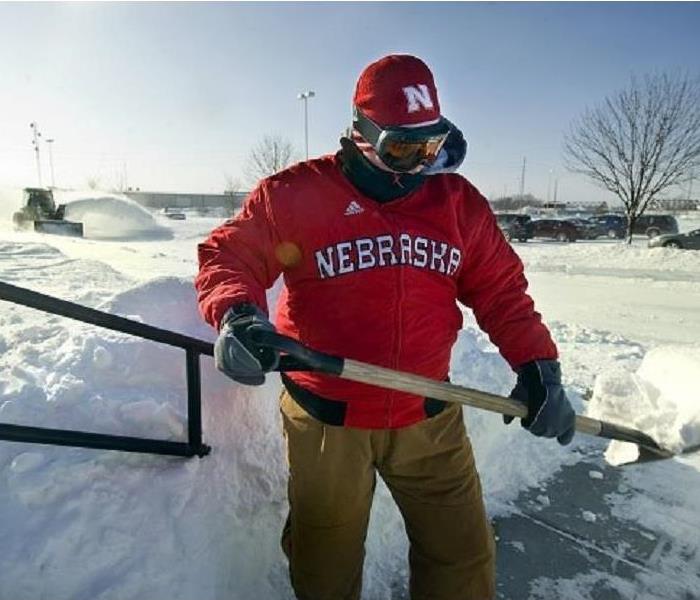 Husker Power!
Husker Power!
Winter Storm Cleanup and Restoration
Cold weather, snow and ice storms can cause severe damage to your home or business. When these types of disasters strike, immediate action is necessary to prevent additional damage to your property. SERVPRO of Lincoln has the winter storm experience, expertise, and the resources to remediate damage caused by winter weather. A few examples are:
Frozen Pipes
Extreme cold weather can cause pipes to freeze and burst. In general, pipes are more likely to freeze when the temperature is below 20 degrees Fahrenheit. The resulting water damage can be extensive. Outdoor pipes and pipes in unheated areas of the home can freeze if they are not properly insulated or if temperatures are severely cold. SERVPRO can quickly and safely repair water damage caused by frozen pipes.
Outdoor pipes most likely to freeze include:
- Outdoor hose bibs
- Swimming pool supply lines
- Water sprinkler lines
Pipes in unheated or partially heated areas are also at risk of freezing, including:
- Basements
- Crawl spaces
- Garages
Ice Dams
An ice dam is formed when snow melts unevenly on a roof and refreezes into a dam at the edge of the roof, near the eaves. This dam prevents any further snowmelt from draining off of the roof. This standing water can back up under shingles, leak into a home, and cause significant water damage to ceilings, walls, and other areas. Ice dams can also tear off gutters and loosen shingles.
Roof Damage
Snow and ice can cause significant damage to your gutters and roof. The additional weight of snow and ice can even cause a roof to collapse. When there’s a cold snap, water can get into cracks and small spaces and expand when it freezes, causing larger cracks and more damage. The repetition of freezing and thawing cycles can cause small cracks to get larger.
Damage from Cold Weather or Winter Storm? Call SERVPRO of Lincoln 402-466-4004
SERVPRO of Lincoln Can Dry Your Beatrice, NE Crawlspace!
9/7/2018 (Permalink)
- To dry out a Beatrice, NE crawlspace, we first have to remove the water. That is not usually a problem, but since this is a storm, the ground is going to be very wet and possibly damaged. SERVPRO technicians understand that means multiple, water-filled low spots. It can be difficult to bring in hoses even in a large crawl space to syphon out the pooling water.
The next step is to lower the humidity as much as possible. Bringing in a dehumidifier is not usually an option, just like pump hoses. We can set up dehumidifiers with flexible plastic conduits to direct the moist air from the space to the exterior. We can also place containers with chemical desiccants in the crawlspace to absorb water from the air. If possible, we set up an air mover above the crawlspace and blow in warm, dry air to displace the damp air we attempt to draw out using an exhaust fan.
Now that we removed the water, SERVPRO technicians encapsulate the crawlspace once the moisture level and soil dampness have been reduced to normal levels. We cover the dirt floor with polyethylene sheets and a polyester mesh for reinforcement. This 12 mil plastic guard covering prevents moisture from leeching up from the ground.
After a foundation expert finishes seal the walls, the polyethylene sheets and polyester mesh floor are sealed to them with waterproof, foundation tape.
Drying out a wet crawlspace is not an easy task. It takes a professional service to remove the water and prevent further intrusion from future storms. To see how we can protect your home, call SERVPRO of Lincoln (402) 466-4004 today. We are here for you.
Protect Yourself AFTER A Storm
9/6/2018 (Permalink)
A few things to keep in mind following storm damage:
Unfortunately, an increase in the number of storm-related claims may lead to an increase in the number of unscrupulous roofers and contractors who are willing to take advantage of homeowners. It is very important for you to be cautious when dealing with contractors who offer to repair your home. Some tips:
- Only do business with licensed contractors with good references.
- Always request a written, detailed estimate.
- Never pay for work up front, nor make any payments in cash.
- Never sign a contract with spaces left blank.
- What is their business address? If the company has a PO Box or doesn't have a local address, they probably aren't a local company.
- Ask about some references for work they have done in this area. Local companies should have plenty of projects you can see in the area.
- If in doubt about anything you are being asked to sign by a contractor, don’t be afraid to ask questions. Don’t feel pressured into signing anything. Take time to do your research, and if you are unsure about anything in the agreement, WAIT until you’ve had an opportunity to look it over more carefully and discuss it with your insurance agent or adjuster.
Be Ready For Spring Storms!
3/20/2018 (Permalink)
Understand Severe Weather Alerts
Do you know the difference between a National Weather Service Severe Thunderstorm Watch and a Severe Thunderstorm Warning? Check your knowledge below.
Severe Thunderstorm Watch: Be Prepared!
Severe thunderstorms are possible in and near the watch area. Stay informed and be ready to act if a severe thunderstorm warning is issued. The watch area is typically large, covering numerous counties or even states.
Severe Thunderstorm Warning:
Take Action! Severe weather has been reported by spotters or indicated by radar. Warnings indicate imminent danger to life and property. Take shelter in a substantial building. Get out of mobile homes that can blow over in high winds. Warnings typically encompass a much smaller area (around the size of a city or small county) that may be impacted by a large hail or damaging wind identified by an NWS forecaster on radar or by a trained spotter/law enforcement who is watching the storm.
Prepare! Don't Let Severe Weather Take You by Surprise
Find out what you can do before severe weather strikes. Preparation is key to staying safe and minimizing impacts.
- Be Weather-Ready: Check the forecast regularly to see if you're at risk for severe weather. Listen to local news or a NOAA Weather Radioto stay informed about severe thunderstorm watches and warnings. Check the Weather-Ready Nation for tips.
- Sign Up for Notifications: Know how your community sends warning. Some communities have outdoor sirens. Others depend on media and smart phones to alert residents to severe storms.
- Create a Communications Plan: Have a family plan that includes an emergency meeting place and related information. Pick a safe room in your home such as a basement, storm cellar or an interior room on the lowest floor with no windows. Get more ideas for a plan at: https://www.ready.gov/make-a-plan
- Practice Your Plan: Conduct a family severe thunderstorm drill regularly so everyone knows what to do if a damaging wind or large hail is approaching. Make sure all members of your family know to go there when severe thunderstorm warnings are issued. Don't forget pets if time allows.
Prepare Your Home : Keep trees and branches trimmed near your house. If you have time before severe weather hits, secure loose objects, close windows and doors, and move any valuable objects inside or under a sturdy structure.
Help Your Neighbor: Encourage your loved ones to prepare for severe thunderstorms. Take CPR training so you can help if someone is hurt during severe weather.
What to Do During Severe Weather
Acting quickly is key to staying safe and minimizing impacts.
- Stay Weather Ready: Continue to listen to local news or a NOAA Weather Radio to stay updated about severe thunderstorm watches and warnings.
- At Your House: Go to your secure location if you hear a severe thunderstorm warning. Damaging wind or large hail may be approaching. Take your pets with you if time allows.
- At Your Workplace or School: Stay away from windows if you are in a severe thunderstorm warning and damaging wind or large hail is approaching. Do not go to large open rooms such as cafeterias, gymnasiums or auditoriums.
- Outside: Go inside a sturdy building immediately if severe thunderstorms are approaching. Sheds and storage facilities are not safe. Taking shelter under a tree can be deadly. The tree may fall on you. Standing under a tree also put you at a greater risk of getting struck by lightning.
- In a Vehicle: Being in a vehicle during severe thunderstorms is safer than being outside; however, drive to closest secure shelter if there is sufficient time.
What to Do After Severe Weather
What should you do when the lightning and thunder stops and it looks likes the severe thunderstorm is over?
- Stay Informed: Continue listening to local news or a NOAA Weather Radio to stay updated about severe thunderstorm watches and warnings. More severe thunderstorms could be headed your way.
- Contact Your Family and Loved Ones: Let your family and close friends know that you're okay so they can help spread the word. Text messages or social media are more reliable forms of communication than phone calls.
- Assess the Damage: After you are sure the severe weather threat has ended, check your property for damages. When walking through storm damage, wear long pants, a long-sleeved shirt and sturdy shoes. Contact local authorities if you see power lines down. Stay out of damaged buildings. Be aware of insurance scammers if your property has been damaged.
- Help Your Neighbor: If you come across people that are injured and you are properly trained, if needed, provide first aid to victims until emergency responders arrive.
Information found at http://www.nws.noaa.gov/om/thunderstorm/
SERVPRO of Lincoln Is Ready When The Storm Hits!
12/21/2017 (Permalink)
SERVPRO of Lincoln specializes in storm and flood damage restoration. Our crews are highly trained and we use specialized equipment to restore your property to its pre-storm condition.
Faster Response
Since we are locally owned and operated, we are able to respond quicker with the right resources, which is extremely important. A fast response lessens the damage, limits further damage, and reduces the restoration cost.
Resources to Handle Floods and Storms
When storms hit Southeast Nebraska, from Seward to Ashland to Beatrice, we can scale our resources to handle a large storm or flooding disaster. We can access equipment and personnel from a network of 1,650 Franchises across the country.
Have Storm or Flood Damage? Call SERVPRO of Lincoln Today 402-466-4004
Beware Lightning During A Thundersnow Event!
12/21/2017 (Permalink)
Thundersnow. Strong winter snowstorms and blizzards commonly produce lightning strikes, a phenomenon referred to as 'thundersnow'. More uncommon than spring and summer thunderstorms, thunder snows do occur in the Midwest, and they are bred by the same unstable weather conditions. Essentially, they are thunderstorms that occur in colder months, and they are accompanied by thunder and lightning. Lightning and thunder can occur with any type of winter precipitation - including snow, sleet ('thundersleet') and freezing rain.
The storm of Oct 1997 in Lincoln, NE was a thundersnow event and dumped over 13 inches of wet snow. If this event happens again, SERVPRO of Lincoln will be ready!
Faster Response
Since we are locally owned and operated, we are able to respond quicker with the right resources, which is extremely important. A fast response lessens the damage, limits further damage, and reduces the restoration cost.
Call SERVPRO of Lincoln If You Have Storm Damage!
9/15/2017 (Permalink)
SERVPRO of Lincoln, NE specializes in storm and flood damage restoration. Our crews are highly trained and we use specialized equipment to restore your property to its pre-storm condition.
Faster Response
Since we are locally owned and operated, we are able to respond quicker with the right resources, which is extremely important. A fast response lessens the damage, limits further damage, and reduces the restoration cost.
Resources to Handle Floods and Storms
When storms hit Lincoln, we can scale our resources to handle a large storm or flooding disaster. We can access equipment and personnel from a network of 1,650 Franchises across the country and elite Disaster Recovery Teams (http://www.SERVPROlincolneast.com/disaster-recovery) that are strategically located throughout the United States.
Have Storm or Flood Damage? Call Us Today at 402-466-4004
Think You Know Everything About Tornadoes?
9/15/2017 (Permalink)
What Causes Tornadoes?
Thunderstorms develop in warm, moist air in advance of eastward-moving cold fronts. These thunderstorms often produce large hail, strong winds, and tornadoes. Tornadoes in the winter and early spring are often associated with strong, frontal systems that form in the Central States and move east. During the spring in the Central Plains, thunderstorms frequently develop along a "dryline," which separates very warm, moist air to the east from hot, dry air to the west. Tornado-producing thunderstorms may form as the dryline moves east during the afternoon hours.
How Do Tornadoes Form?
Before thunderstorms develop, a change in wind direction and an increase in wind speed with increasing height creates an invisible, horizontal spinning effect in the lower atmosphere. Rising air within the thunderstorm updraft tilts the rotating air from horizontal to vertical. An area of rotation, 2 - 6 miles wide, now extends through much of the storm. Most strong and violent tornadoes form within this area of strong rotation
Tornadoes Take Many Shapes and Sizes
Weak Tornadoes
- 69% of all tornadoes
- Less than 5% of tornado deaths
- Lifetime 1-10+ minutes
- Winds less than 110 mph
Strong Tornadoes
- 29% of all tornadoes
- Nearly 30% of all tornado deaths
- May last 20 minutes or longer
- Winds 110-205 mph
Violent Tornadoes
- Only 2% of all tornadoes
- 70% of all tornado deaths
- Lifetime can exceed 1 hour
- Winds greater than 205 mph
Tornado Myths:
MYTH: Areas near rivers, lakes and mountains are safe from tornadoes.
FACT: No place is safe from tornadoes. In the late 1980's, a tornado swept through Yellowstone National Park leaving a path of destruction up and down a 10,000 ft. mountain.
MYTH: The low pressure with a tornado causes buildings to "explode" as the tornado passes overhead.
FACT: Violent winds and debris slamming into buildings cause most structural damage.
MYTH: Windows should be opened before a tornado approaches to equalize pressure and minimize damage.
FACT: Opening windows allows damaging winds to enter the structure. Leave the windows alone; instead, immediately go to a safe place.
Tornadoes can occur at any time of the year
- In the southern states, peak tornado occurrence is in March through May, while peak months in the northern states are during the summer.
- Note, in some states, a secondary tornado maximum occurs in the fall.
- Tornadoes are most likely to occur between 3 and 9 p.m. but have been known to occur at all hours of the day or night.
- The average tornado moves from southwest to northeast, but tornadoes have been known to move in any direction. The average forward speed is 30 mph but may vary from nearly stationary to 70 mph.
- The total number of tornadoes is probably higher than indicated in the western states. Sparse population reduces the number reported.
SERVPRO of Lincoln Wants You To Be Storm Ready!
9/15/2017 (Permalink)
Severe weather can happen anytime, anywhere. Each year, Americans cope with an average of:
- 10,000 severe thunderstorms
- 5,000 floods or flash floods
- 2 land falling deadly hurricanes
Approximately 98% of all declared disasters (by the president) are weather-related, leading to around 500 deaths per year and nearly $15 billion in damage*. Knowing your risk of severe weather, taking a few actions and being an example to others are just a few steps you can take to be better prepared to save your life and assist in saving the lives of others.
Know your risk. The first step to becoming weather-ready is to understand the type of hazardous weather that can affect where you live and work, and how the weather could impact you, your business and your family. Check the weather forecast regularly, obtain a NOAA Weather Radio, and learn about Wireless Emergency Alerts. Severe weather comes in many forms and your shelter plan should include all types of local hazards.
Take Action. Take the next step in severe weather preparedness by creating a communication plan for your home and business. Put together or purchase an emergency kit. Keep important papers and valuables in a safe place.
Be an Example. Once you have taken action to prepare for severe weather, share your story with co-workers and family and friends on Facebook or Twitter. Your preparedness story will inspire others to do the same.
Build an Emergency Supply Kit:
- Water (one gallon per person per day)
- Food (non-perishable 3-day supply)
- Battery operated radio, preferably a NOAA Weather Radio
- Flashlight and extra batteries
- Whistle to signal for help
- Plastic sheeting, garbage bags and duct tape
- Wrench or pliers to turn off utilities
- Important documents; copies of insurance policies, identification and bank account information
- Matches in a waterproof container
NOTE: Statistics gathered from www.stormready.noaa.gov
How To Prevent Further Storm Damage
9/15/2017 (Permalink)
Prevent Further Storm Damage By Using Certified Technicians
While storm damage may have happened on only one side or corner of your home, that damage can quickly spread. Water that has been able to enter during the storm through any openings created by falling trees or broken glass can evaporate and find its way into other rooms, and even onto other levels of your home.
Removing Storm Damage and the Mess it Makes Should be Done Carefully and Professionally
Storm damage can cause unexpected hazards. If your Lincoln home or small business has experienced storm damage, you should not attempt to clean the debris up yourself. We have professional technicians who are trained in clearing away the debris. We have experience in extracting standing water, cleaning water damaged items and structures, and can help prevent mold growth.
Cleaning alone is often not enough, as storm damage and subsequent rainfall will damage interior structures. We can prevent much of the damage, and repair what has already taken place. Repairs and restoration work can be done so that the new materials match the original ones. We have training and certification in restorative work that makes this possible.
From removing the debris to final restorative touches, we can quickly make things look “Like they never even happened,” ensuring you and your family can return to your home safely. The same goes for your small business or office. Don't let storm damage ruin your home or your business.
For storm damage clean up and repairs, call SERVPRO of Lincoln 24/7 at (402) 466-4004. We will respond to your emergency as quickly as possible to start cleaning up the debris and repairing the damage.
What Do You Know About Tornadoes?
5/6/2016 (Permalink)
Although tornadoes occur in many parts of the world, these destructive forces of nature are found most frequently in the United States east of the Rocky Mountains during the spring and summer months. In an average year, 800 tornadoes are reported nationwide, resulting in 80 deaths and over 1,500 injuries. A tornado is defined as a violently rotating column of air extending from a thunderstorm to the ground. The most violent tornadoes are capable of tremendous destruction with wind speeds of 250 mph or more. Damage paths can be in excess of one mile wide and 50 miles long. Once a tornado in Broken Bow, Oklahoma, carried a motel sign 30 miles and dropped it in Arkansas!
What Causes Tornadoes?
Thunderstorms develop in warm, moist air in advance of eastward-moving cold fronts. These thunderstorms often produce large hail, strong winds, and tornadoes. Tornadoes in the winter and early spring are often associated with strong, frontal systems that form in the Central States and move east. During the spring in the Central Plains, thunderstorms frequently develop along a "dryline," which separates very warm, moist air to the east from hot, dry air to the west. Tornado-producing thunderstorms may form as the dryline moves east during the afternoon hours.
How Do Tornadoes Form?
Before thunderstorms develop, a change in wind direction and an increase in wind speed with increasing height creates an invisible, horizontal spinning effect in the lower atmosphere. Rising air within the thunderstorm updraft tilts the rotating air from horizontal to vertical. An area of rotation, 2 - 6 miles wide, now extends through much of the storm. Most strong and violent tornadoes form within this area of strong rotation
Tornadoes Take Many Shapes and Sizes
Weak Tornadoes- 69% of all tornadoes
- Less than 5% of tornado deaths
- Lifetime 1-10+ minutes
- Winds less than 110 mph
Strong Tornadoes- 29% of all tornadoes
- Nearly 30% of all tornado deaths
- May last 20 minutes or longer
- Winds 110-205 mph
Violent Tornadoes- Only 2% of all tornadoes
- 70% of all tornado deaths
- Lifetime can exceed 1 hour
- Winds greater than 205 mph
Tornado Myths:
MYTH: Areas near rivers, lakes and mountains are safe from tornadoes.
FACT: No place is safe from tornadoes. In the late 1980's, a tornado swept through Yellowstone National Park leaving a path of destruction up and down a 10,000 ft. mountain.
MYTH: The low pressure with a tornado causes buildings to "explode" as the tornado passes overhead.
FACT: Violent winds and debris slamming into buildings cause most structural damage.
MYTH: Windows should be opened before a tornado approaches to equalize pressure and minimize damage.
FACT: Opening windows allows damaging winds to enter the structure. Leave the windows alone; instead, immediately go to a safe place.
Tornadoes can occur at any time of the year
- In the southern states, peak tornado occurrence is in March through May, while peak months in the northern states are during the summer.
- Note, in some states, a secondary tornado maximum occurs in the fall.
- Tornadoes are most likely to occur between 3 and 9 p.m. but have been known to occur at all hours of the day or night.
- The average tornado moves from southwest to northeast, but tornadoes have been known to move in any direction. The average forward speed is 30 mph but may vary from nearly stationary to 70 mph.
- The total number of tornadoes is probably higher than indicated in the western states. Sparse population reduces the number reported.
What to Listen For...- SEVERE THUNDERSTORM WATCH: Severe thunderstorms are possible in your area.
- SEVERE THUNDERSTORM WARNING: Severe thunderstorms are occurring.
- TORNADO WATCH: Tornadoes are possible in your area. Remain alert for approaching storms.
- TORNADO WARNING: A tornado has been sighted or indicated by weather radar. If a tornado warning is issued for your area and the sky becomes threatening, move to your pre-designated place of safety.
Remember, tornadoes occasionally develop in areas in which a severe thunderstorm watch or warning is in effect. Remain alert to signs of an approaching tornado and seek shelter if threatening conditions exist. Environmental CluesLook out for:- Dark, often greenish sky
- Wall cloud
- Large hail
- Loud roar; similar to a freight train
Caution:Some tornadoes appear as a visible funnel extending only partially to the ground.
Some tornadoes are clearly visible while others are obscured by rain or nearby low-hanging clouds. It's Up to YOU!
Each year, many people are killed or seriously injured by tornadoes despite advance warning. Some did not hear the warning while others received the warning but did not believe a tornado would actually affect them. This preparedness information, combined with timely severe weather watches and warnings, could save your life in the event a tornado threatens your area. After you have received the warning or observed threatening skies, YOU must make the decision to seek shelter before the storm arrives. It could be the most important decision you will ever make.
When Storms or Floods hit Lincoln, NE, SERVPRO is ready!
4/27/2016 (Permalink)
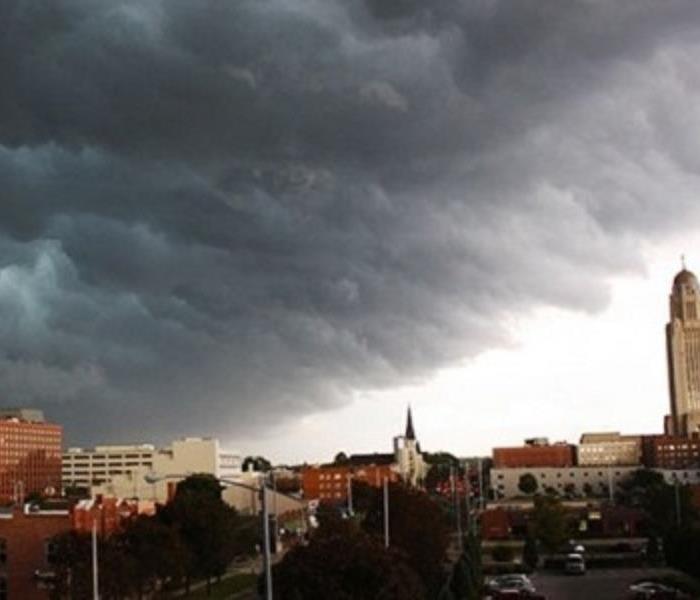 Our highly trained crews are ready to respond 24/7 to storm or flood damage in Lincoln, NE
Our highly trained crews are ready to respond 24/7 to storm or flood damage in Lincoln, NE
SERVPRO ofLincoln, NE specializes in storm and flood damage restoration. Our crews are highly trained and we use specialized equipment to restore your property to its pre-storm condition.
Faster Response
Since we are locally owned and operated, we are able to respond quicker with the right resources, which is extremely important. A fast response lessens the damage, limits further damage, and reduces the restoration cost.
Resources to Handle Floods and Storms
When storms hit Lincoln, we can scale our resources to handle a large storm or flooding disaster. We can access equipment and personnel from a network of 1,650 Franchises across the country and elite Disaster Recovery Teams (http://www.SERVPROlincolneast.com/disaster-recovery) that are strategically located throughout the United States.
Have Storm or Flood Damage? Call Us Today at 402-466-4004





 24/7 Emergency Service
24/7 Emergency Service





